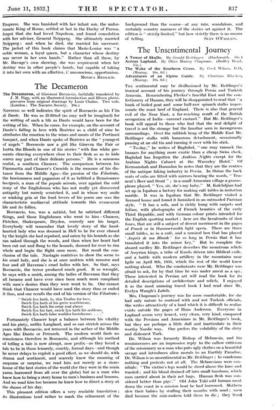The Decameron
The Decameron, of Giovanni Boccaccio, faithfully translated by J. M. Rigg, with an illustrated introduction and fifteen photo- gravures from original drawings by Louis Chalon. Two vols. (London The Navarre Society. 30s.)
Narimsa so well indicates the spirit of Boccaccio as his Vita di Dante. He was as ill-fitted (as may well be imagined) for the writing of such a life as Dante would have been for the writing of his. When he came, for example, on the account of Dante's falling in love with Beatrice as a child of nine he attributes the emotion to the wines and meats of the Portinari banquet, and when Dante spoke of Beatrice as the " youngest of angels" Boccaccio saw a girl like Ginevra the Fair or Isotta the Blonde in one of his stories "with fine white gar- ments cleaving everywhere close to their flesh so as to hide scarce any part of their delicate persons." He is a sensuous realist, a southern Chaucer. The comparison between his Fiammetta and Chaucer's Creseide is the measure of his dis- tance from the Middle Ages—the passion of the Filostrato, the lusciousness and paganism of it as befitted a Renaissance bourgeois, a man of the populo minuto, over against the cold irony of the Englishman who has not really yet discovered antiquity but merely scratched it, and in whose wry smile or winking grin at the fond lovers of his poem one sees the cluiracteristic mediaeval attitude towards this evanescent life and its follies.
Boccaccio, too, was a satirist, but he satirized different things, and those Englishmen who went to him—Chaucer, Fletcher, Shakespeare, Dryden, scarcely saw his target. Everybody will remember that lovely story of the hard- hearted lady who was doomed in Hell to be for ever chased by the knight she had repulsed, and eaten by his hounds as she ran naked through the woods, and then when her heart had been cut out and flung to the hounds, doomed for ever to rise whole and begin the flight once more. But recall the con- clusion of the tale. Nastagio contrives to show the scene to hM cruel lady, and she is at once smitten with remorse and fear and all Ravenna's cruel ladies with her. So that, says Boccaccio, the terror produced much good. It so wrought, he says with a smirk, among the ladies of Ravenna that they all became and have ever since been much more compliant with men's desires than they were wont to be. One cannot think that .Chaucer would have used the story thus or ended it thus, and one recalls the end of his version of the Filostrato :
"Swich fyn hath, lo, this Troilus for love, Swich fyn hath al his grete worthiness°, Swich fyn bath his estat real above Swich fyn his lust, swich fyn hath his noblesse, Swich fyn bath false worldes brotainesse. . ."
Fortunately Chaucer kept a balance between his vitality and his piety, unlike Langland, and so can stretch across the years with Boccaccio, not removed in the nether of the Middle Ages like Dante or Petrareh. The modern world finds no remoteness therefore in Boccaccio, and although his method of telling a tale is now abrupt, now prolix—as they loved a tale to be in those leisurely, courtly, formal days—and though he never delays to exploit a good effect, as we should do, with drama and sentiment, and scarcely knew the meaning of suspense or surprise, we read him not merely as a store- house of the best stories of the world (for they were in the main yarns borrowed from all over the globe) but as a man who knew how to bring a story home to men's business and bosoms. And we read him too because he knew how to direct a story at the shams of his day.
' This pleasant edition offers a very readable translation ; its illustrations tend rather to mark the refinement of the
background than the coarse—at any rate, scandalous, and certainly country manners of the stories set against it. The edition is "strictly limited," but how strictly there is no means


































 Previous page
Previous page